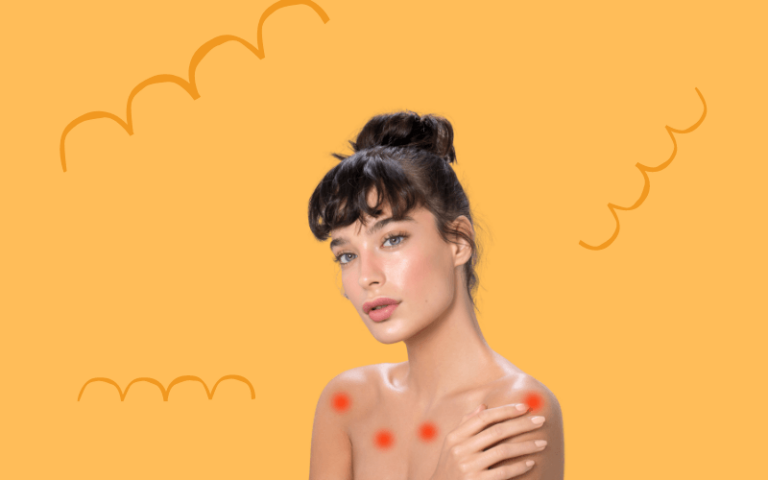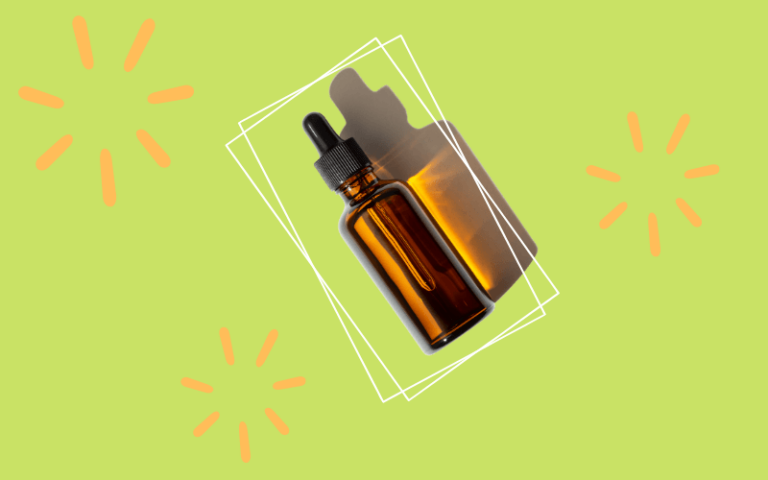The Secret Trick To Getting Rid Of Scalp Acne For Good

There’s nothing like waking up to the familiar feeling of a bump, except it’s not on your face.
Whew.
But wait. A zit on your head? Seriously? Unfortunately — facial acne isn’t the only type of acne breakout.
We already have enough zits to worry about on our faces such as blind pimples, and now we have to worry about zits on our scalps, too?
Welp, here we are. So get nice and cozy—and let’s find out how to banish these bad boys.
What exactly is the cause of scalp acne?
Okay, so I guess we can confirm that scalp acne IS indeed, a thing. Let’s take a look into what causes them:
Scalp folliculitis is a skin condition that occurs when hair follicles get clogged with dead skin cells and excess oil, also known as sebum.
Add bacteria to the mix and we have the culprit for a full-blown scalp acne breakout waiting to happen.
The most common areas for scalp acne are around the hairline and forehead, but they can appear anywhere throughout the scalp.
So, why does it happen?
Hair follicles get clogged with excess oil and form acne for several reasons.
The biggest, are using too many styling products without properly cleansing them out, not cleaning the scalp frequently enough, and not keeping the scalp dry from sweat and moisture.
Genetics also play a role. Some of us are naturally more oily and sensitive to acne than others.
There’s one more contributing factor to the cause of scalp acne and yes, you guessed it… hormones.
Just as our hormones can impact the severity and frequency of the zits on our face, they can also play a role in whether or not our scalp will breakout.
Regardless of the cause, clogged pores on top of the head cause inflammation that results in pustules and red bumps that can be very sore.
Types of scalp acne
There are several types of acne that can be classified as scalp folliculitis:
- Blackheads: Tiny bumps that form from the overproduction of sebum in the hair follicle. The surface appears dark or black. They are considered one of the more mild types of acne.
- Whiteheads: Closed comedones that are tiny with a white head, also a mild type of acne.
- Seborrheic dermatitis: This is flaky, itchy scales and feels like dry skin. It’s more commonly known as dandruff.
- Cystic acne: More severe type of acne. Sometimes referred to as nodules, lesions, or papules, cysts go deeper beneath the skin’s surface.
- Fungal acne: A type of acne that is caused by an overproduction of yeast within the skin’s microbiome.
Age range of scalp acne
Scalp acne affects people of all ages but is most common during puberty and in those going through a hormonal change such as pregnancy.
Blemishes that start with puberty are typically temporary and go away with time.
As if these life changes didn’t give us enough to worry about!
However, blemishes can occur on your scalp at any age if you’re not keeping your head dry and properly washed.
Scalp acne caused by pregnancy and hormonal changes often goes away when hormones re-stabilize. Thank goodness.
Preventing scalp acne for good
Staying on top of scalp acne may seem intimidating but it’s key to reducing the chance of pimples, especially if external factors such as puberty and hormonal imbalances are present.
You can prevent scalp acne by proper scalp hygiene, keeping the scalp dry, and eating a balanced diet.
Sounds easy enough, right? Let’s talk about it.
Cleanse your hair regularly
Haircare is important for many reasons, especially in reducing the chance of scalp breakouts.
Oily skin is more prone to breakouts as the sebaceous glands produce more sebum which can clog pores. Nobody wants a greasy scalp!
Reducing product buildup is an important step in your hair care routine.
If you don’t properly cleanse your hair to clean the pores, flakes and zits can appear.
Use a clarifying shampoo 1-2x per week to get rid of product buildup.
Hair products can also trigger acne by producing excess buildup.
Common ones are hair lotions, gels, and conditioners. Pay attention if you notice more pimples erupting when you use certain products.
Keep track of your diet
We’ve all heard that the vitamins and minerals we eat affect our health.
Getting enough nutrients and antioxidants in our diet is key to giving our body the good stuff to prevent inflammation—and in the case of scalp acne, preventing zits.
Severe cases of zits can be a result of vitamin deficiency.
Your doctor can do blood work to see which vitamin levels are low.
In most cases, eating more vitamin-rich foods full of nutrients and antioxidants, or opting to take supplements, is enough to get your levels back on track.
A good way to know if you’re getting enough variety in your diet is to eat the rainbow!
Choose vegetables and fruits of different colors to ensure you’re getting a wide spectrum of vitamins.
As important as consuming the right foods can be, making sure to eliminate trigger foods can also be extremely beneficial for improving your skin complexion.
Foods such as dairy have been found as a likely culprit of the formation of acne.
Keep track of the foods you consume regularly and experiment with the process of eliminating certain foods one at a time to see if it contributes to any changes in your skin.
This may sound time-consuming but trust me, your skin will (seriously) thank you!
Wear loose-fitting headgear
Nobody likes to sweat!
Unfortunately, those cute headbands and hats we wear to keep our heads warm can cause irritation and discomfort on the hairline and forehead due to the tight fabric.
Be sure to wear loose-fitting headgear and keep your head dry.
If you’re working out or live in a humid environment, then you’re more susceptible to sweat which leads to excess sebum in the oil glands.
Depending on the time of the year, you may also experience more moisture.
The American Academy of Dermatology recommends cleaning your scalp and showering as soon as possible after working out at the gym.
Keep your hair utensils clean
Keeping your hair utensils and any tools used for shaving sanitized helps prevent the bacteria that causes acne.
It’s also a good idea overall to get used to cleaning anything that touches your body, not just things you use on your hair!
For scalp issues, this includes any combs, brushes, or razors you use. If you are shaving your head, be sure to keep your razor clean.
You can keep hair utensils clean by thoroughly washing them with soap and water and leaving them in rubbing alcohol to kill any lingering bacteria.
Adios, germs.
There are also spray disinfectants that can be used to sanitize your hair utensils to ensure cleanliness and reduce the risk of infection.
Check your hair care products
When it comes to scalp acne, it’s important to check your current hair care products for any ingredients that may trigger acne breakouts.
Products that contain oils, acids, and other synthetic ingredients may trigger excess oil production or cause rashes and itching.
In severe cases, harsh chemicals in hair care products are even linked to potential hair loss.
To avoid further irritation or potential hair loss, opt for natural products with gentler ingredients.
Always be sure to cleanse your hair after using any daytime hair products to remove any excess gel, hair spray, wax, and crusts that may have built up on your follicles throughout the day.
Effective treatments
Finally, what you’ve been waiting for. Let’s get down to business and talk about the best treatments for your scalp acne.
Spot treatments
Propionibacterium acnes refers to chronic, slow-growing acne that needs to be treated with a spot treatment routinely to prevent bumps and pimples from getting worse.
You can use spot treatments to treat zits, nodules, and bumps.
You may already have some of these products since the same ingredients that work for the pimples on your face will work on your scalp, too!
Spot treatments are available as both sprays and creams and can be used on different parts of the body.
Benzoyl peroxide, anyone?
Benzoyl peroxide is a strong antibacterial ingredient.
Use it sparingly on painful bumps and pimples, starting a few times a week since benzoyl peroxide can be drying for sensitive skin.
Experiment with products that have different percentages of this ingredient and see what leads to the best results for your scalp.
Natural spot treatments
Tea tree oil is a natural alternative used to treat bumps and pimples. You can buy tea tree oil over-the-counter.
Pure tea tree oil is very strong and can cause irritation if it’s not diluted. To make your own spot treatment, dilute a few drops with an oil such as jojoba or argan.
Rosemary oil is another popular natural ingredient that aids in reducing redness.
How often/how can I spot treat?
Spot treatments can be used daily if you experience no irritation.
It’s always best to start out applying it a few times a week to determine your skin’s reaction.
You can use spot treatments on your zits daily after washing and drying your hair as needed.
The American Academy of Dermatology’s website recommends a few methods for applying your spot treatment.
One of the most effective ways of applying it is along the part of your hair, in 2” sections throughout your scalp.
Opt for different shampoo/conditioner
Certain shampoos and conditioners may trigger scalp issues.
Shampoos with too much fragrance, dyes, or oils can trigger inflammation that can cause rashes, dryness, and breakouts.
If you aren’t using a shampoo that thoroughly cleans the scalp, then you won’t get rid of the dead skin cells that collect and get trapped by excess sebum which triggers acne breakouts.
Look for a medicated shampoo
Medicated shampoos have different active ingredients such as salicylic acid and glycolic acid to fight acne by chemically exfoliating the scalp.
Others containing sulfur, ketoconazole, and ciclopirox fight acne caused by fungus and dandruff.
If you don’t know which to use, pick one and experiment!
What may not be very effective for some may work great for others.
You can use medicated shampoos on your scalp for a few moments longer than normal (as you would using a hair mask) to allow the skin to fully absorb the ingredients within the product.
These shampoos can be found at the drugstore and will list their active ingredients on the back.
Tips on conditioners
Beware of using heavy conditioners as they can cause product buildup on your scalp and clog the oil glands.
This can happen if you don’t properly rinse the conditioner from your hair or if you’re using a conditioner that’s too heavy for your hair type.
Opt for a conditioner marketed towards oily hair or daily-use if this is the case.
How often should I wash my scalp?
You should adjust the frequency of how often you wash your scalp based on the type of hair you have.
The American Academy of Dermatology recommends cleansing oily hair once a day while drier hair can be washed every 2-3 days.
If you don’t want to cleanse your hair too often you can try adding a dry shampoo to your routine to absorb any excess sebum.
Dry shampoos can deliver the same cleaning abilities without the hassle of getting your hair wet.
Resist the urge to pop it!
If you take one piece of advice from us it’s this: don’t pop zits on your scalp! Or ever, really.
It will only make them worse.
Popping pimples cause inflammation around the pores which can immediately cause scarring, and in worst-case scenarios, leave a noticeable scar.
The pus from a popped pimple can also spread bacteria to the surrounding pores which can lead to the formation of more pimples.
It’s hard to resist the urge to pop a zit, especially when they itch and are painful.
Whenever you feel the urge, apply your preferred spot treatment or wash your hair with a medicated shampoo to prevent the urge to pop your pimples and avoid any permanent scars.
When to see a dermatologist
Feeling like you’ve exhausted all of your over-the-counter options?
If so, it’s time to see a doctor. Your M.D. or derm will be able to diagnose scalp folliculitis and tell you the best treatment.
They can also advise as to whether or not to treat it with an antifungal, antibacterial, or another type of ingredient.
In severe cases, your M.D. or dermatologist may refer you to a trichologist, which is a hair and scalp specialist.
A trichologist will be able to go further and determine if you’re suffering from folliculitis, scabies, ringworm, allergic reaction, or poison ivy.
Possible prescriptions to expect
Your dermatologist can prescribe medicated shampoos and topicals that have ingredients that aren’t available over-the-counter as well as products with a higher percentage of active ingredients.
Other prescriptions and treatments to achieve more permanent results can be administered by your dermatologist.
They may prescribe steroid creams or antibiotics to reduce inflammation.
Prescription medications such as oral isotretinoin which is a vitamin A derivative in a pill form may be prescribed when the acne doesn’t respond to oral antibiotics or topical medications.
Dermatologists can also offer topicals that help with scarring.
Key takeaways
Scalp folliculitis can itch and be a pain in the ‘you know what’— but it doesn’t have to be that way forever!
With a few changes to your lifestyle, you can win the fight against scalp acne.
It’s a good idea to get ahead of your zits.
Be sure you’re getting enough vitamins in your diet, avoid tight clothing, clean your hair utensils, and Keep. That. Scalp. Dry.
Don’t forget to leave those pimples alone since popping them will only make them worse.
If you already have scalp acne, try a spot treatment or medicated shampoo, re-evaluate your hair products, and consider seeing a dermatologist.
Keeping a routine to clear scalp acne may seem overwhelming, but the good news is that after incorporating these steps you’ll be sure to see a difference.
Sources
- “Acne.” National Institutes of Health, 2016, niams.nih.gov/health-topics/acne
- “Acne.” Women’s Health, 2018, womenshealth.gov/a-z-topics/acne
- Bienenfeld A, et al. Androgens in women: Androgen-mediated skin disease and patient evaluation Journal of the American Academy of Dermatology, 2019, 10.1016/j.jaad.2018.08.062
- “How to prevent common skin infections at the gym.” American Academy of Dermatology, https://www.youtube.com/watch?v=u4ruysjfWEE&ab_channel=AmericanAcademyofDermatology
- “How to treat dandruff.” American Academy of Dermatology, https://www.youtube.com/watch?v=wcYUod1AthY&ab_channel=AmericanAcademyofDermatology





